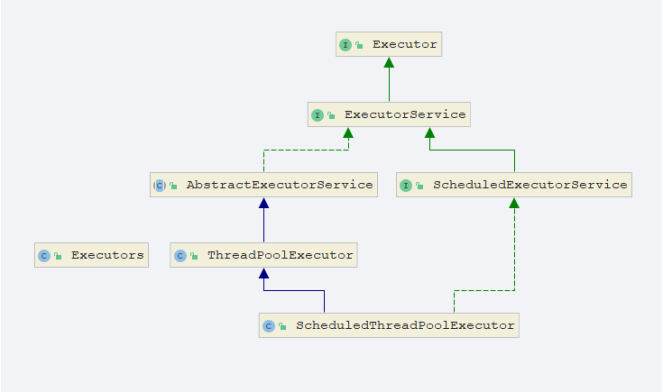=====文章目录=====
问题
线程池的好处和不足在哪儿?
线程池底层实现原理是?
日常开发中如何用好线程池?
线程池实际用哪一个?
线程池ThreadPoolExecutor
概念
线程池做的工作主要是控制运行的线程的数量,处理过程中将任务加入队列,然后在线程创建后启动这些任务,如果发生超过了最大数量,超出的数量的线程排队等候,等其他线程执行完毕,再从队列中取出任务来执行.
优点
他的主要特点为:线程复用、控制最大并发数、管理线程.
- 线程复用:不用一直new新线程,重复利用已经创建的线程来降低线程的创建和销毁开销,节省系统资源。
- 提高响应速度:当任务达到时,不用创建新的线程,直接利用线程池的线程。
- 管理线程:可以控制最大并发数,控制线程的创建等。
体系
Executor→ExecutorService→AbstractExecutorService→ThreadPoolExecutor。ThreadPoolExecutor是线程池创建的核心类。类似Arrays、Collections工具类,Executor也有自己的工具类Executors。
架构实现
Java中的线程池是通过Executor框架实现的,该框架中用到了Executor,Executors,ExecutorService,ThreadPoolExecutor这几个类.

线程池如何使用
线程池三种常用创建方式
newFixedThreadPool:使用LinkedBlockingQueue实现,定长线程池。
public static ExecutorService newFixedThreadPool(int nThreads) {
return new ThreadPoolExecutor(nThreads, nThreads,
0L, TimeUnit.MILLISECONDS,
new LinkedBlockingQueue<Runnable>());
}
newSingleThreadExecutor:使用LinkedBlockingQueue实现,一池只有一个线程。
public static ExecutorService newSingleThreadExecutor() {
return new FinalizableDelegatedExecutorService(new ThreadPoolExecutor(1, 1,
0L, TimeUnit.MILLISECONDS,
new LinkedBlockingQueue<Runnable>()));
}
newCachedThreadPool:使用SynchronousQueue实现,变长线程池。
public static ExecutorService newCachedThreadPool() {
return new ThreadPoolExecutor(0, Integer.MAX_VALUE,
60L, TimeUnit.SECONDS,
new SynchronousQueue<Runnable>());
线程池七大参数
int corePoolSize,核心线程
int maximumPoolSize,非核心线程
long keepAliveTime,时间
TimeUnit unit,时间单位
BlockingQueue<Runnable> workQueue,队列
ThreadFactory threadFactory,线程工厂
RejectedExecutionHandler handler 拒绝策略
表格
| 参数 | 意义 |
|---|---|
| corePoolSize | 线程池常驻核心线程数 |
| maximumPoolSize | 能够容纳的最大线程数 |
| keepAliveTime | 空闲线程存活时间 |
| unit | 存活时间单位 |
| workQueue | 存放提交但未执行任务的队列 |
| threadFactory | 创建线程的工厂类 |
| handler | 等待队列满后的拒绝策略 |
方法注释
corePoolSize – the number of threads to keep in the pool, even if they are idle, unless allowCoreThreadTimeOut is set
maximumPoolSize – the maximum number of threads to allow in the pool
keepAliveTime – when the number of threads is greater than the core, this is the maximum time that excess idle threads will wait for new tasks before terminating.
unit – the time unit for the keepAliveTime argument
workQueue – the queue to use for holding tasks before they are executed. This queue will hold only the Runnable tasks submitted by the execute method.
threadFactory – the factory to use when the executor creates a new thread
handler – the handler to use when execution is blocked because the thread bounds and queue capacities are reached
代码
public ThreadPoolExecutor(int corePoolSize,
int maximumPoolSize,
long keepAliveTime,
TimeUnit unit,
BlockingQueue<Runnable> workQueue,
ThreadFactory threadFactory,
RejectedExecutionHandler handler) {
if (corePoolSize < 0 ||
maximumPoolSize <= 0 ||
maximumPoolSize < corePoolSize ||
keepAliveTime < 0)
throw new IllegalArgumentException();
if (workQueue == null || threadFactory == null || handler == null)
throw new NullPointerException();
this.acc = System.getSecurityManager() == null ?
null :
AccessController.getContext();
this.corePoolSize = corePoolSize;
this.maximumPoolSize = maximumPoolSize;
this.workQueue = workQueue;
this.keepAliveTime = unit.toNanos(keepAliveTime);
this.threadFactory = threadFactory;
this.handler = handler;
}
理解:线程池的创建参数,就像一个银行。
corePoolSize就像银行的“当值窗口“,比如今天有2位柜员在受理客户请求(任务)。如果超过2个客户,那么新的客户就会在等候区(等待队列workQueue)等待。当等候区也满了,这个时候就要开启“加班窗口”,让其它3位柜员来加班,此时达到最大窗口maximumPoolSize,为5个。如果开启了所有窗口,等候区依然满员,此时就应该启动”拒绝策略“handler,告诉不断涌入的客户,叫他们不要进入,已经爆满了。由于不再涌入新客户,办完事的客户增多,窗口开始空闲,这个时候就通过keepAlivetTime将多余的3个”加班窗口“取消,恢复到2个”当值窗口“。
流程
如果正在运行的线程数小于corePoolSize,创建核心线程;大于等于corePoolSize,放入等待队列。
如果等待队列已满,但正在运行的线程数小于maximumPoolSize,创建非核心线程;大于等于maximumPoolSize,启动拒绝策略。
当一个线程无事可做一段时间keepAliveTime后,如果正在运行的线程数大于corePoolSize,则关闭非核心线程。
线程池的拒绝策略

当等待队列满时,且达到最大线程数,再有新任务到来,就需要启动拒绝策略。JDK提供了四种拒绝策略,分别是。
- AbortPolicy:默认的策略,直接抛出
RejectedExecutionException异常,阻止系统正常运行。 - CallerRunsPolicy:既不会抛出异常,也不会终止任务,而是将任务返回给调用者。
- DiscardOldestPolicy:抛弃队列中等待最久的任务,然后把当前任务加入队列中尝试再次提交任务。
- DiscardPolicy:直接丢弃任务,不做任何处理。
实际生产使用哪一个线程池(重点)?
图片来自阿里java开发手册嵩山版

单一、可变、定长都不用!原因就是FixedThreadPool和SingleThreadExecutor底层都是用LinkedBlockingQueue实现的,这个队列最大长度为Integer.MAX_VALUE,显然会导致OOM。所以实际生产一般自己通过ThreadPoolExecutor的7个参数,自定义线程池。
ExecutorService threadPool=new ThreadPoolExecutor(2,5,
1L,TimeUnit.SECONDS,
new LinkedBlockingQueue<>(3),
Executors.defaultThreadFactory(),
new ThreadPoolExecutor.AbortPolicy());
自定义线程池参数选择
CPU密集型任务
对于CPU密集型任务,最大线程数是CPU线程数+1。
CPU密集的意思是该任务需要大量的运算,而没有阻塞,CPU一直全速运行
CPU密集任务只有在真正的多核cPU上才可能得到加速(通过多线程),
而在单核CPU上(悲剧吧?),无论你开几个模拟的多线程该任务都不可能得到加速,因为CPU总的运算能力就那些。
CPU密集型任务配置尽可能少的线程数量:
一般公式:CPU核数+1个线程的线程池
IO密集型任务
对于IO密集型任务,尽量多配点,可以是CPU线程数*2,或者CPU线程数/(1-阻塞系数)。
某大厂经验
IO密集型,即该任务需要大量的|O,即大量的阻塞。
在单线程上运行lO密集型的任务会导致浪费大量的cPU运算能力浪费在等待
所以在IO密集型任务中使用多线程可以大大的加速程序运行,即使在单核CPU上,这种加速主要就是利用了被浪费掉的阻塞时间。
IO密集型时,大部分线程都阻塞,故需要多配置线程数
参考公式:CPU核数/1-阻塞系数
阻塞系数在0.8~09之间
比如8核CPU: 8 /(1-0.9)=80个线程数
说说线程池底层工作原理(重点)

以下内容很重要 ,以下内容很重要,以下内容很重要
1.在创建了线程池后,等待提交过来的任务请求。
2.当调用 execute(方法添加一个请求任务时,线程池会做如下判断
2.1如果正在运行的线程数量小于 corePoolSize,那么马上创建线程运行这个任务;
2.2如果正在运行的线程数量大于或等于 corePoolSize,那么将这个任务放入队列
2.3如果这时候队列满了且正在运行的线程数量还小于 maximumPoolSize,那么还是要创建非核心线程立刻运行这个仼务
2.4如果队列满了且正在运行的线程数量大于或等于 maximumPoolSize,那么线程池会启动饱和拒绝策略来执行。
3.当一个线程完成任务时,它会从队列中取下一个任务来执行。
4.当一个线程无事可做超过一定的时间( keepAlive Time)时,线程池会判断:
如果当前运行的线程数大于corePoolSize,那么这个线程就被停掉。
所以线程池的所有任务完成后它最终会收缩到 corePoolsize的大小。
如何查看CPU核心数
鼠标右键,No!!!
System.out.println(Runtime.getRuntime().availableProcessors());
参考资料
java并发编程——线程池ThreadPoolExecutor使用
阿里大佬带你,深入理解线程池底层原理
JVM-JUC-Core
阿里java开发手册嵩山版.pdf